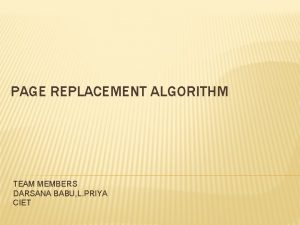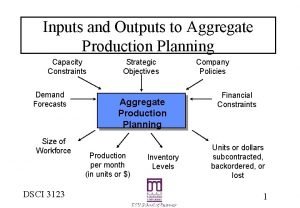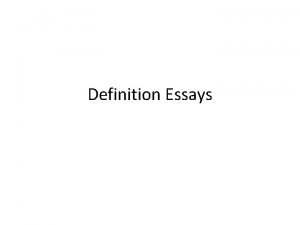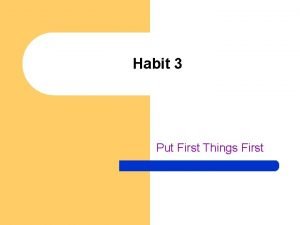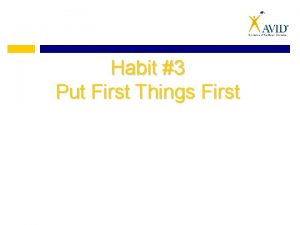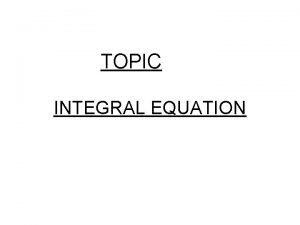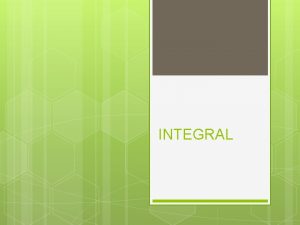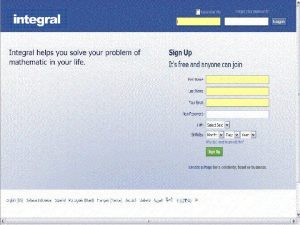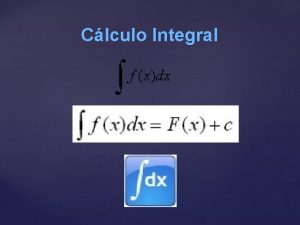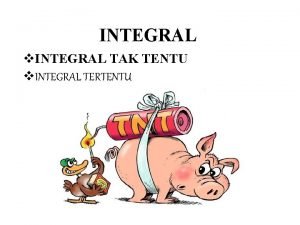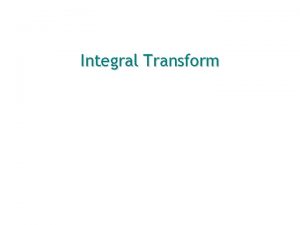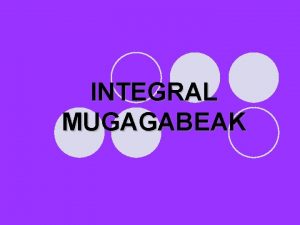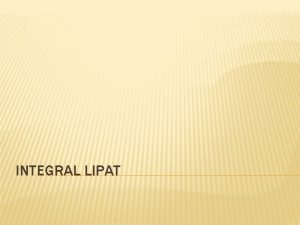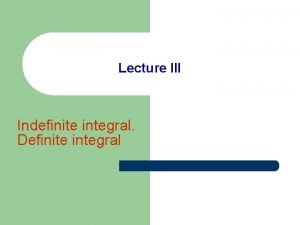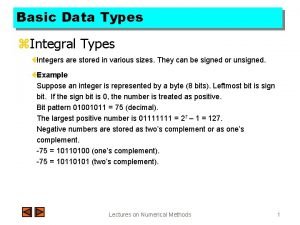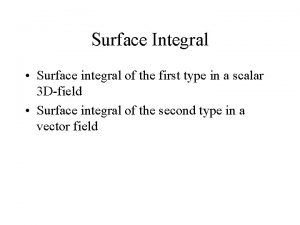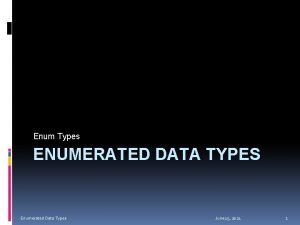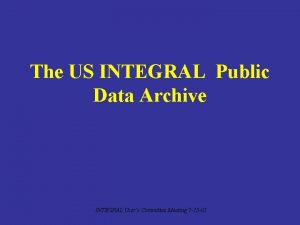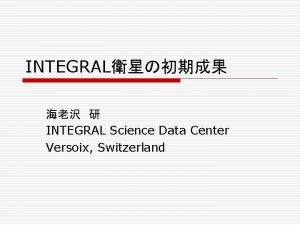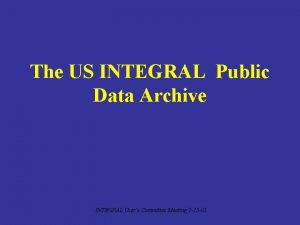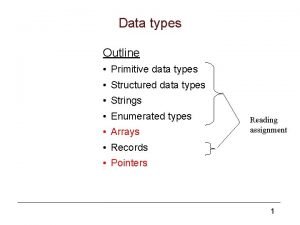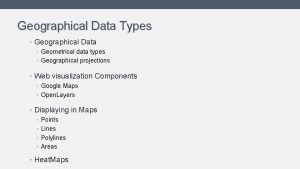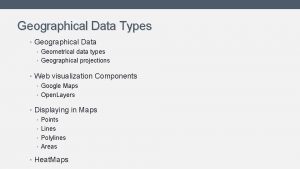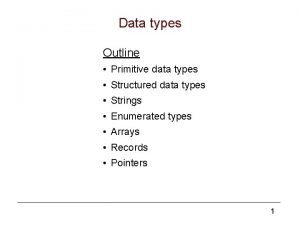Integral Data Types in C 1 First lecture



































- Slides: 35

Integral Data Types in C 1

• First lecture response sent out • • • Lots of good questions Some questions will be punted to reading when appropriate 3 statements useful – found a few misunderstandings Need to focus on statements, not just nouns Still need pictures • Gedankenexperiment • What happens when you crank a stereo system to 11 (and beyond)? 2

Goals for this Lecture • Help you to learn about: • The binary number system • Why binary? • Converting between decimal and binary • The octal and hexadecimal number systems • Finite representations of binary integers • Unsigned integers • Integer addition • Signed integers • Bitwise operators • And, or, not, and xor • Shift-left and shift-right • The C integral data types • char, short, int, long (signed and unsigned) 3

Why Bits (Binary Digits)? • Computers are built using digital circuits • Inputs and outputs can have only two values • True (high voltage) or false (low voltage) • Represented as 1 and 0 • Can represent many kinds of information • • • Boolean (true or false) Numbers (23, 79, …) Characters (‘a’, ‘z’, …) Pixels Sound • Can manipulate in many ways • • Read and write Logical operations Arithmetic … 4

Base 10 and Base 2 • Decimal (base 10) • Each digit represents a power of 10 • 4173 = 4 x 103 + 1 x 102 + 7 x 101 + 3 x 100 • Binary (base 2) • Each bit represents a power of 2 • 10110 = 1 x 24 + 0 x 23 + 1 x 22 + 1 x 21 + 0 x 20 = 22 Decimal to binary conversion: Divide repeatedly by 2 and keep remainders 12/2 = 6 R = 0 6/2 = 3 R = 0 3/2 = 1 R = 1 1/2 = 0 R = 1 Result = 1100 5

Writing Bits is Tedious for People • Octal (base 8) • Digits 0, 1, …, 7 • Hexadecimal (base 16) • Digits 0, 1, …, 9, A, B, C, D, E, F 0000 = 0 0001 = 1 0010 = 2 0011 = 3 0100 = 4 0101 = 5 0110 = 6 0111 = 7 1000 = 8 1001 = 9 1010 = A 1011 = B 1100 = C 1101 = D 1110 = E 1111 = F Thus the 16 -bit binary number 1011 0010 1001 converted to hex is B 2 A 9 6

Representing Colors: RGB • Three primary colors • Red • Green • Blue • Strength • 8 -bit number for each color (e. g. , two hex digits) • So, 24 bits to specify a color • In HTML, on the course Web page • Red: <font color="#FF 0000"><i>Symbol Table Assignment Due</i> • Blue: <font color="#0000 FF"><i>Fall Recess</i></font> • Same thing in digital cameras • Each pixel is a mixture of red, green, and blue 7

Finite Representation of Integers • Fixed number of bits in memory • Usually 8, 16, or 32 bits • Unsigned integer • No sign bit • Always positive or 0 • All arithmetic is modulo 2 n • Examples of unsigned integers • • • 00000001 1 00001111 15 00010000 16 00100001 33 1111 255 8

Adding Two Integers: Base 10 • From right to left, we add each pair of digits • We write the sum, and add the carry to the next column 0 1 1 + 0 0 1 2 Sum 1 0 0 1 Carry 0 1 1 1 9 8 + 2 6 4 Sum 4 6 Carry 0 1 9

Binary Sums and Carries a 0 0 1 1 b 0 1 Sum 0 1 1 0 a 0 0 1 1 b 0 1 Carry 0 0 0 1 AND XOR 69 0100 0101 + 0110 0111 103 1010 1100 172 10

Modulo Arithmetic • Consider only numbers in a range • E. g. , five-digit car odometer: 0, 1, …, 99999 • E. g. , eight-bit numbers 0, 1, …, 255 • Roll-over when you run out of space • E. g. , car odometer goes from 99999 to 0, 1, … • E. g. , eight-bit number goes from 255 to 0, 1, … • Adding 2 n doesn’t change the answer • For eight-bit number, n=8 and 2 n=256 • E. g. , (37 + 256) mod 256 is simply 37 • This can help us do subtraction… • Suppose you want to compute a – b • Note that this equals a + (256 -1 - b) + 1 11

One’s and Two’s Complement • One’s complement: flip every bit • E. g. , b is 01000101 (i. e. , 69 in decimal) • One’s complement is 10111010 • That’s simply 255 -69 • Subtracting from 1111 is easy (no carry needed!) 1111 - 0100 0101 1010 b one’s complement • Two’s complement • Add 1 to the one’s complement • E. g. , (255 – 69) + 1 1011 12

Putting it All Together • Computing “a – b” • • Same as “a + 256 – b” Same as “a + (255 – b) + 1” Same as “a + ones. Complement(b) + 1” Same as “a + twos. Complement(b)” • Example: 172 – 69 • • • The original number 69: One’s complement of 69: Two’s complement of 69: Add to the number 172: The sum comes to: Equals: 103 in decimal 0100 0101 1010 1011 1010 1100 0111 1010 1100 + 1011 1 0110 0111 13

Signed Integers • Sign-magnitude representation • Use one bit to store the sign • Zero for positive number • One for negative number • Examples • E. g. , 0010 1100 44 • E. g. , 1010 1100 -44 • Hard to do arithmetic this way, so it is rarely used • Complement representation • One’s complement • Flip every bit • E. g. , 1101 0011 -44 • Two’s complement • Flip every bit, then add 1 • E. g. , 1101 0100 -44 14

Overflow: Running Out of Room • Adding two large integers together • Sum might be too large to store in the number of bits available • What happens? • Unsigned integers • All arithmetic is “modulo” arithmetic • Sum would just wrap around • Signed integers • Can get nonsense values • Example with 16 -bit integers • Sum: 10000+20000+30000 • Result: -5536 15

Bitwise Operators: ANDand OR • Bitwise AND (&) • Bitwise OR (|) | & 0 1 0 0 0 1 1 1 0 1 • Mod on the cheap! • E. g. , h = 53 & 15; 53 0 0 1 1 0 1 & 15 0 0 1 1 5 0 0 0 1 16

Bitwise Operators: Not and XOR • One’s complement (~) • Turns 0 to 1, and 1 to 0 • E. g. , set last three bits to 0 • x = x & ~7; • XOR (^) • 0 if both bits are the same • 1 if the two bits are different ^ 0 0 1 1 1 0 17

Bitwise Operators: Shift Left/Right • Shift left (<<): Multiply by powers of 2 • Shift some # of bits to the left, filling the blanks with 0 53 0 0 1 1 0 0 53<<2 1 1 0 0 0 0 • Shift right (>>): Divide by powers of 2 • Shift some # of bits to the right • For unsigned integer, fill in blanks with 0 • What about signed negative integers? Varies across machines… • Can vary from one machine to another! 53 0 0 1 1 0 0 53>>2 0 0 1 18

Data Types • Programming languages combine: • Bits into bytes • Bytes into larger entities • Combinations of bytes have types; why? • Facilitates abstraction • Enables compiler to do type checking • C has 11 primitive data types • 8 integral data types (described in this lecture) • 3 floating-point data types (described in next lecture) 19

C Integral Data Types • Integral types: Type Bytes Typically Used to Store signed char 1 The numeric code of a character unsigned char 1 The numeric code of a character (signed) short 2* A small integer unsigned short 2* A small non-negative integer (signed) int 4* An integer unsigned int 4* A non-negative integer (signed) long 4* An integer unsigned long 4* A non-negative integer * On hats; C 90 standard does not specify size 20

C Integral Data Types (cont. ) • Why char vs. short vs. int vs. long? • Small sizes conserve memory • Large sizes provide more range • Why signed vs. unsigned? • Signed types allow negatives • Unsigned types allow greater positives • (Dubious value: Java omits unsigned types) • When to use unsigned? • When you really need that extra bit • When you’ll do lots of bit shifting • When you’ll never do (a < 0) test 21

The int Data Type • Description: A positive or negative integer • Same as signed int • Size: System dependent • 16 <= bits in short <= bits in int <= bits in long • Usually 16 bits (alias 2 bytes) or 32 bits (alias 4 bytes) • The “natural word size” of the computer 22

The int Data Type (cont. ) • Example constants (assuming 4 bytes) Two’s complement High-order bit indicates sign Constant Binary Representation Note 123 00000000 01111011 decimal form -123 11111111 10000101 negative form 2147483647 011111111 1111 largest -2147483648 100000000 0000 smallest 0173 00000000 01111011 octal form 0 x 7 B 00000000 01111011 hexadecimal form Leading zero means octal Leading zero-x means hexadecimal 23

The unsigned int Data Type • Description: A positive integer • Size: System dependent • Same as int • Example constants (assuming 4 bytes) Constant Binary Representation Note 123 U 00000000 01111011 decimal form 4294967295 U 11111111 largest 0 U 00000000 smallest 0173 U 00000000 01111011 octal form 0 x 7 BU 00000000 01111011 hexadecimal form Note “U” suffix Same range as int, but shifted on number line 24

The long Data Type • Description: A positive or negative integer • Same as signed long • Size: System dependent • 16 <= bits in short <= bits in int <= bits in long • Usually 32 bits, alias 4 bytes • Example constants (assuming 4 bytes) Constant Binary Representation Note 123 L 00000000 01111011 decimal form -123 L 11111111 10000101 negative form 2147483647 L 011111111 1111 largest -2147483648 L 100000000 0000 smallest 0173 L 00000000 01111011 octal form 0 x 7 BL 00000000 01111011 hexadecimal form Note “L” suffix 25

The unsigned long. Data Type • Description: A positive integer • Size: System dependent • Same as long • Example constants (assuming 4 bytes) Constant Binary Representation Note 123 UL 00000000 01111011 decimal form 4294967295 UL 11111111 largest 0 UL 00000000 smallest 0173 UL 00000000 01111011 octal form 0 x 7 BUL 00000000 01111011 hexadecimal form Note “UL” suffix 26

The short Data Type • Description: A positive or negative integer • Same as signed short • Size: System dependent • 16 <= bits in short <= bits in int <= bits in long • Usually 16 bits, alias 2 bytes • Example constants (assuming 2 bytes) Constant Binary Representation Note (short)123 0000 01111011 decimal form (short)-123 1111 10000101 negative form (short)32767 01111111 largest (short)-32768 10000000 smallest (short)0173 0000 01111011 octal form (short)0 x 7 B 0000 01111011 hexadecimal form No way to express constant of type short, so must use cast 27

The unsigned short. Data Type • Description: A positive integer • Size: System dependent • Same as short • Example constants (assuming 4 bytes) Constant Binary Representation Note (unsigned short)123 U 0000 01111011 decimal form (unsigned short)65535 U 11111111 largest (unsigned short)0 U 00000000 smallest (unsigned short)0173 U 0000 01111011 octal form (unsigned short)0 x 7 BU 0000 01111011 hexadecimal form No way to express constant of type unsigned short, so must use cast 28

The signed char Data Type • Description: A (small) positive or negative integer • Size: 1 byte • Example constants Constant Binary Representation Note (signed char)123 01111011 decimal form (signed char)-123 10000101 negative form (signed char)127 01111111 largest (signed char)-128 10000000 smallest (signed char)0173 01111011 octal form (signed char)0 x 7 B 01111011 hexadecimal form No way to express constant of type signed char, so must use cast 29

The unsigned char. Data Type • Description: A (small) positive integer • Size: 1 byte • Example constants Constant Binary Representation Note (unsigned char)123 01111011 decimal form (unsigned char)255 1111 largest (unsigned char)0 0000 smallest (unsigned char)0173 01111011 octal form (unsigned char)0 x 7 B 01111011 hexadecimal form No way to express constant of type unsigned char, so must use cast 30

The char Data Type • On some systems, char means signed char • On other systems, char means unsigned char • Obstacle to portability int a[256]; char c; c = (char)255; … … a[c] … /* char is unsigned => a[255] => OK */ /* char is signed => a[-1] => out of bounds */ 31

The char Data Type (cont. ) • On your system, is char signed or unsigned? #include <stdio. h> int main(void) { char c = (char)0 x 80; if (c > 0) printf("unsigned"); else printf("signed"); return 0; } • Output on hats signed 32

The char Data Type (cont. ) • Q: • Why is type char called “char” (meaning “character”)? • A: • Type char can be used for limited range arithmetic • As indicated previously • However, type char is used more often to store a character code • As shown next lecture 33

Summary • Computer represents everything in binary • Integers, floating-point numbers, characters, addresses, … • Pixels, sounds, colors, etc. • Binary arithmetic through logic operations • Sum (XOR) and Carry (AND) • Two’s complement for subtraction • Binary operations in C • AND, OR, NOT, and XOR • Shift left and shift right • Useful for efficient and concise code, though sometimes cryptic • C integral data types • char, short, int, long (signed and unsigned) 34

35
 01:640:244 lecture notes - lecture 15: plat, idah, farad
01:640:244 lecture notes - lecture 15: plat, idah, farad Indefinite integral
Indefinite integral Non-integral citation
Non-integral citation Blair matthews
Blair matthews Contoh soal integral permukaan
Contoh soal integral permukaan Exchange difference of integral foreign operation is
Exchange difference of integral foreign operation is Anti turunan
Anti turunan Integral data type example
Integral data type example La lecture au primaire
La lecture au primaire Hamza kashgari
Hamza kashgari Exploratory data analysis lecture notes
Exploratory data analysis lecture notes Bayesian classification in data mining lecture notes
Bayesian classification in data mining lecture notes Data mining lecture notes
Data mining lecture notes Data visualization lecture
Data visualization lecture Data mining lecture notes
Data mining lecture notes Data mining lecture notes
Data mining lecture notes Descriptive mining of complex data objects
Descriptive mining of complex data objects Data representation in computer organization
Data representation in computer organization Mining complex data types
Mining complex data types Complex data types in data mining
Complex data types in data mining Sharpen the saw examples
Sharpen the saw examples Breadth first search
Breadth first search Sdl first vs code first
Sdl first vs code first Habit 3 lesson plans
Habit 3 lesson plans Habit 3
Habit 3 Entity framework 7 release date
Entity framework 7 release date First to file vs first to invent
First to file vs first to invent Data structure stack
Data structure stack![Stack=[] digunakan untuk memebuat stack dengan Stack=[] digunakan untuk memebuat stack dengan](data:image/svg+xml,%3Csvg%20xmlns=%22http://www.w3.org/2000/svg%22%20viewBox=%220%200%20200%20200%22%3E%3C/svg%3E) Stack=[] digunakan untuk memebuat stack dengan
Stack=[] digunakan untuk memebuat stack dengan First in first out
First in first out First come first serve
First come first serve Put first things first definition
Put first things first definition Gantt chart first come first serve
Gantt chart first come first serve Put first things first
Put first things first Habit 3 put first things first
Habit 3 put first things first Put first things first video
Put first things first video

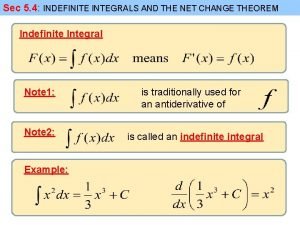
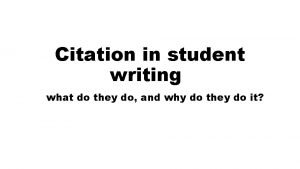


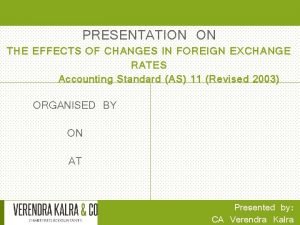







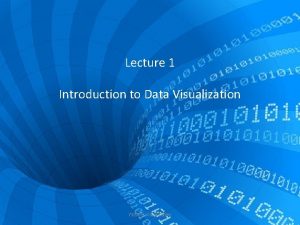
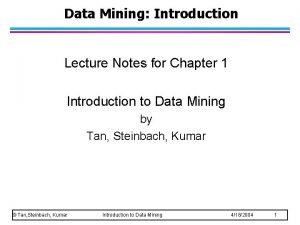
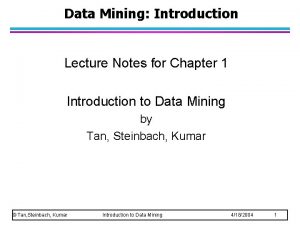

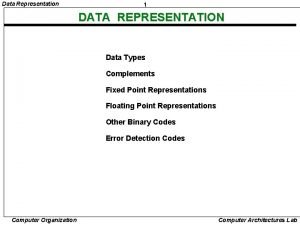



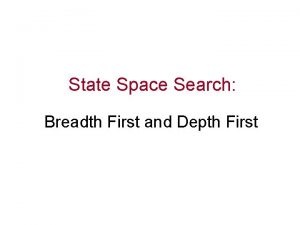
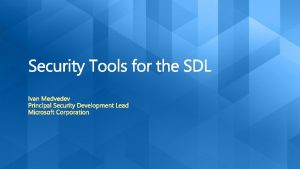
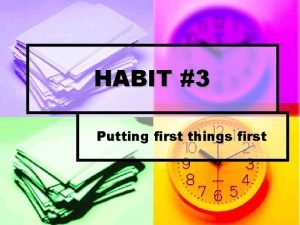
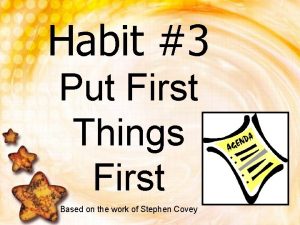
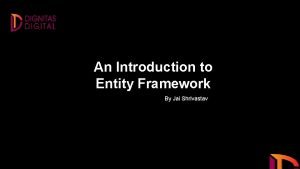
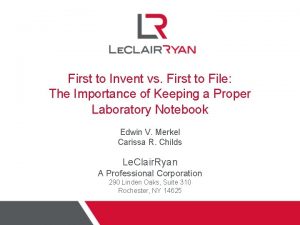
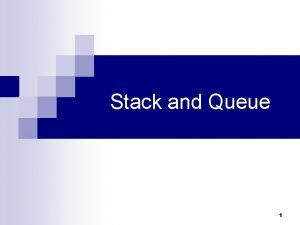
![Stack=[] digunakan untuk memebuat stack dengan Stack=[] digunakan untuk memebuat stack dengan](https://slidetodoc.com/wp-content/uploads/2020/10/1003988_042512bb86e3aab910dfb86ac5697e60-300x212.jpg)
